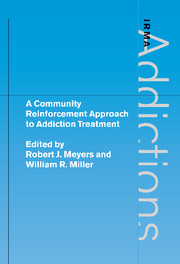Book contents
- Frontmatter
- Contents
- List of contributors
- Preface
- Acknowledgments
- 1 Developing the Community Reinforcement Approach
- 2 Practice and Promise: The Azrin Studies
- 3 The Treatment
- 4 A Comparison of CRA and Traditional Approaches
- 5 Community Reinforcement and Traditional Approaches: Findings of a Controlled Trial
- 6 CRA with the Homeless
- 7 CRA and Treatment of Cocaine and Opioid Dependence
- 8 Community Reinforcement and Family Training (CRAFT)
- 9 Summary and Reflections
- References
- Index
8 - Community Reinforcement and Family Training (CRAFT)
Published online by Cambridge University Press: 05 August 2012
- Frontmatter
- Contents
- List of contributors
- Preface
- Acknowledgments
- 1 Developing the Community Reinforcement Approach
- 2 Practice and Promise: The Azrin Studies
- 3 The Treatment
- 4 A Comparison of CRA and Traditional Approaches
- 5 Community Reinforcement and Traditional Approaches: Findings of a Controlled Trial
- 6 CRA with the Homeless
- 7 CRA and Treatment of Cocaine and Opioid Dependence
- 8 Community Reinforcement and Family Training (CRAFT)
- 9 Summary and Reflections
- References
- Index
Summary
Background and research
It has become clearly evident that the behavior of an individual with a substance-abuse problem can have a pronounced negative impact on the lives of family members and friends (Collins, Leonard & Searles, 1990; Orford & Harwin, 1982; Velleman et al., 1993). Paolino and McCrady (1977) estimated that for every excessive drinker there are five others who suffer directly. Problems experienced by these significant others range from mild verbal abuse to severe physical violence. Other negative effects documented by the loved ones of substance-abusing individuals include depressed mood, physical complaints, low self-confidence, and high levels of anxiety (Brown et al., 1995; Kogan & Jacobson, 1965; Moos, Finney & Gamble, 1982). Additionally, these concerned significant others (CSOs) report elevated levels of marital distress (Thomas & Ager, 1993).
A scientifically based model designed to help these CSOs engage resistant substance abusers into treatment was not available until the early 1980s. Traditionally, assistance for family members was limited to an Al-Anon-based approach and the Johnson Institute intervention. The former taught individuals to detach from substance abusers, and the latter utilized a surprise group confrontation. Importantly, the behavioral program called the Community Reinforcement Approach (CRA; Azrin et al., 1982; Hunt & Azrin, 1973) has always operated with quite a different view of the role that a CSO could play in the treatment of substance abuse. For example, CRA has enlisted CSOs successfully as disulfiram monitors, partners in marital counseling, active agents in resocialization and reinforcement programs, and detection monitors for relapse (Azrin, 1976; Azrin et al., 1982; Hunt & Azrin, 1973; Smith, Meyers & Delaney, 1998).
Keywords
- Type
- Chapter
- Information
- A Community Reinforcement Approach to Addiction Treatment , pp. 147 - 160Publisher: Cambridge University PressPrint publication year: 2001
- 13
- Cited by



